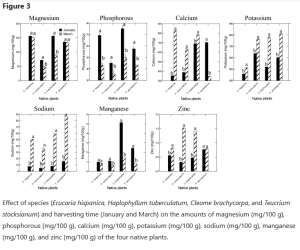
Exploring the Nutritional Potential of UAE's Native Fodder Plants; Erucaria hispanica, Haplophyllum tuberculatum, Convolvulus virgatus, Teucrium stocksianum, and Cleome brachycarpa
In a groundbreaking study, researchers have explored the nutritional and chemical profiles of five native fodder plants found along the eastern coast of the United Arab Emirates. The study, published in Scientific Reports, investigates the impact of harvest timing and plant parts on the nutrient content of Erucaria hispanica, Haplophyllum tuberculatum, Convolvulus virgatus, Teucrium stocksianum, and Cleome brachycarpa. These plants, traditionally used by local farmers to enhance livestock health, have been largely understudied in terms of their nutritional value and seasonal variations.
The research focused on two main objectives: first, to determine how the nutrient content of these plants varies with the season, and second, to assess the distribution of nutrients within different plant parts. Plant samples were collected during January and March, representing early and late winter, respectively. The environmental conditions during these months, including temperature, rainfall, and humidity, were carefully recorded to understand their influence on the nutrient profile of the plants.
The study employed rigorous analytical methods to determine the content of dry matter, ash, crude fiber, crude fat, total digestible nutrients (TDN), tannins, and total sugars in the plants. Additionally, the mineral composition, including essential elements like magnesium, phosphorous, calcium, potassium, and various heavy metals, was analyzed using advanced techniques such as inductively coupled plasma atomic emission spectroscopy (ICP-AES) and flame photometry.
One of the key findings was the significant effect of both species and harvesting time on the mineral content of the plants. For instance, the magnesium content in Cleome brachycarpa and Erucaria hispanica was notably higher in January compared to March. Similarly, the phosphorous content was significantly higher in Cleome brachycarpa during January, while Erucaria hispanica had the highest calcium content in January among all species studied. These variations highlight the importance of considering both the type of plant and the timing of harvest to optimize the nutritional benefits for livestock.
Moreover, the study revealed interesting patterns in nutrient distribution within plant parts. For example, the crude fiber content varied significantly between leaves and stems, suggesting that different parts of the plant may serve distinct nutritional roles. The findings also indicated that the local practice of using these plants as fodder is supported by their rich nutrient profiles, which positively impact the weight and health of livestock such as sheep, cattle, and camels.
This research underscores the potential of native fodder plants in the UAE as valuable resources for sustainable livestock farming. By understanding the nutritional dynamics of these plants, farmers can make informed decisions about harvesting times and plant parts to maximize the benefits for their animals. Additionally, the study highlights the need for further research into other native species and their potential applications in agriculture and animal husbandry.
In conclusion, the detailed analysis provided by this study offers a comprehensive understanding of the nutritional and chemical profiles of five key fodder plants in the UAE. This knowledge can significantly contribute to improving livestock nutrition and supporting sustainable agricultural practices in arid regions. The findings serve as a testament to the importance of integrating traditional knowledge with scientific research to enhance food security and agricultural resilience. The full study can be accessed at: Check for updates. Verify currency and authenticity via CrossMark
Cite this article
Tsombou, F.M., Saeed Sulaiman Jemei Al Dhanhani, A., Mirza, S.B. et al. Effect of harvest timing and plant parts on the nutritional and chemical profile of five potential fodder plants found in eastern coast of United Arab Emirates. Sci Rep 14, 11371 (2024). https://doi.org/10.1038/s41598-024-62258-x
